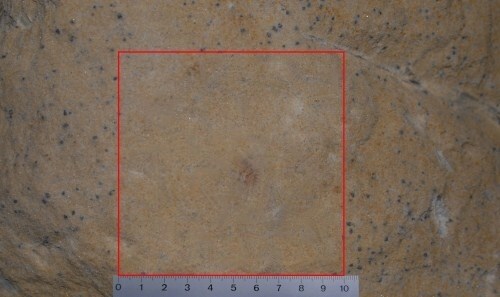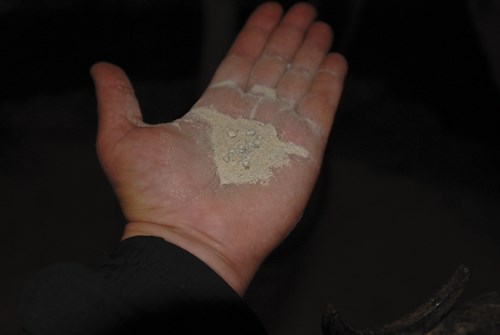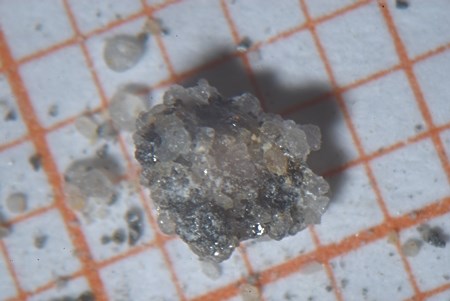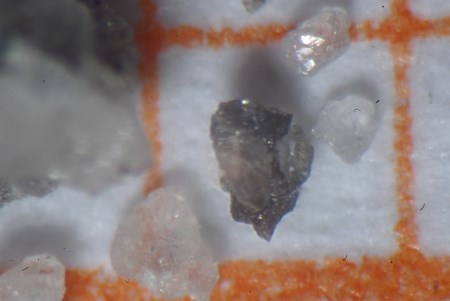Arme Eifel : Der Bleigehalt der Erze Günnersdorf EarthCache
Arme Eifel : Der Bleigehalt der Erze Günnersdorf
-
Difficulty:
-

-
Terrain:
-

Size:  (not chosen)
(not chosen)
Please note Use of geocaching.com services is subject to the terms and conditions
in our disclaimer.
Wergzeug erforderlich: Lineal und Digitalkamera
Wergzeug vereist: liniaal en digitale camera
Tools required: ruler and digital camera
Um diesen Cache zu loggen, ist ein kostenpflichtiger Besuch des Bergbaumuseums Mechernich mit Bergwerksführung erforderlich!
Om deze cache te loggen, een bezoek aan het mijnmuseum Mechernich met de mijne beheer is noodzakelijk!
To log this cache, a paid visit to the mining museum Mechernich with guided mine tour is required!
Öffnungszeiten / Shedule:
Tage
Day |
Uhrzeit
Time |
Montag
Monday |
Ruhetag
Closed |
Dienstag - Samstag
Tuesday - Saturday |
14:00 - 16:00 |
| Sonntag/Sunday |
11:00 - 16:00 |
Eintrittspreise / Entrance fees:
|
EURO |
Erwachsene
Adults |
5,50 |
Kinder u. Jugendliche
Children |
4,00 |
Familienkarte (1 Kind)
Family (1 child) |
13,00 |
jedes weitere Kind
every further child |
2,00 |
Gruppenkarte ab 7 Personen
Groups from 7 persons |
|
Erwachsene
Adults |
4,5 |
Kinder
Children |
3,00 |
Please find the english description below
Hallo liebe Cacher,
hier in der Eifel bei Mechernich wurde schon zur Römerzeit nach Blei geschürft. Das Bergwerk Günnersdorf war bis 1957 aktiv und mußte dann aus wirtschaftlichen Gründen schließen.
Ein Grund dafür, neben stark gefallenen Weltmarktpreisen für Blei, ist der hier nur sehr geringe Gehalt an Blei im anstehenden Erz. Diesen Gehalt wollen wir hier einmal annähernd selber bestimmen.
Logbedingungen:
- Bestimmt den Bleigehalt eines Stückes Erz im Bergwerk (Anleitung unten) in vol-% Blei. Wieviele Kügelchen könnt ihr zählen?
- Erkundet das gemahlene Erz und nehmt Euch einige Bleierzkugeln mit.
- Versucht zu Hause, die Körner ganz von Sand zu reinigen und Bestimmt die Größe der Kugeln vor und nach der Reinigung.
- Sendet uns die Antworten über unser Profil.
Ihr könnt sofort loggen, wir melden uns, wenn etwas nicht stimmt.
Wie kann man nun den Bleigehalt abschätzen?
Hier im Bergwerk Günnersdorf liegt das Bleierz als Galenit vor, einem grauen, metallisch glänzenden Erz. Durch heiße wäßrige Lösungen (sog. hydrothermale Bildung) sind hier Galenit-Körner im weißen Sandstein entstanden, sogenannte "Knotten".
Sucht Euch bei Eurem Bergwerksbesuch eine Stelle aus, an der man diesen Sandstein sehr gut sehen kann. Haltet das Lineal an den Felsen/Stein. Macht mit der Digitalkamera ein Bild (Nahaufnahme) ähnlich dem hier folgenden Bild:

Bild 1: Sandstein mit Erzkörnern und Lineal
Image 1: Sand stone with ore cores and ruler
DIESES BILD MUSS NIRGENDWO HOCHGELADEN WERDEN! Ihr benötigt es nur zu Hause für die Bestimmung des Bleigehaltes.
Öffnet nun das Bildbearbeitungsprogramm Eures Vertrauens und zieht einen quadratischen Rahmen 10 x 10 cm auf dem Foto auf (siehe Bild). Zählt in dem Quadrat alle Erzkörner. Tip: das geht ganz leicht, wenn man im Grafikprogramm die "Knotten" einfach mit dem Radierer wegklickt und die Klicks zählt!
Bei Betrieb des Bergwerkes wurden die Erzkörner durch mahlen und gravimetrische Trennung im Wasser (sog. Flotation) aus diesem Sandstein herausgelöst. Das Rohprodukt dafür ist also körniger weißer Sand wie im nächsten Bild:

Bild 2: gemahlener Sandstein mit Erzkörnern
Image 2 : milled sand stone with ore cores
Wie groß ist so ein Erzkorn?
Im nächsten Bild seht Ihr ein Korn aus dem gemahlenen Erz, das Ihr im Bergwerk findet.

Bild 3: Galenit-Korn unter dem Mikroskop
Image 3: Galenit particle under microscope
Auch wenn aller Sand entfernt wurde, ist das Erz noch sehr fest mit einer Schicht Quarzkörnern versintert. Wenn man allen Quarz mit Gewalt entfernt, kommt man zum nächsten Bild:

Bild 4: Erzkorn ohne Quarzschicht
Image 4: ore particle without quartz sphere
Diese Korn ist nur 1/4 mm2 groß! Die mittlere Größe der Körner aus unserer Sandprobe betrug etwa 1,2 mm2.
Damit könnt Ihr nun den Bleigehalt abschätzen:
Bleierz-Gehalt % = 100 x Anzahl Körner x 1,2 mm2 / (100 x 100 mm2)
Bei dem Bleierz handelt es sich um Bleisulfid, chemisch PbS. Aus Berechnung mit den Atomgewichten der Elemente Blei und Schwefel ergibt sich, das dieses Bleierz nur zu 86,6% aus Blei besteht. Blei, das aus diesem Galenit gewonnen wird, enthält darüber hinaus noch etwa 5% Fremdmetalle. Damit gilt für den Bleigehalt
Bleigehalt % = Bleierz-Gehalt % x 0,866 x 0,95
Viel Spaß beim Bestimmen!
Anmerkung
Bei der Verhüttung dieses Erzes im sog. Röst-Reduktionsprozess gehen noch mal einige % Blei durch den Schornstein verloren (genau das ist der Grund für den Bau des höchsten Schornsteines hier: um die lokalen Besucher nicht zu vergiften). 1957 betrug der Weltmarkpreis für Blei etwa 950 $ pro Tonne Blei. Stellt Euch vor, wieviel Tonnen Erz die Arbeiter damals hier für eine Tonne Blei schürfen mußten... Gegenwärtig liegt der Preis für Blei bei etwa 2300$ pro Tonne Metall und hier in der Eifel liegen immer noch geschätzte 5% der Weltreserven!
Dear Cachers,
here in the area of Eifel near Mechernich lead ore was explored beginning with the late roman empire. The mine 'Bergwerk Günnersdorf' was active until 1957 and was forced to close due to economically reasons.
One reason, by side of strongly decreased world market prices for lead, was the very poor content of lead ore in the sand stone. This lead content we will determine with this EarthCache listing.
Logging tasks:
- Determine the lead content of one ore piece (description see below) in vol-% lead. How many pieces can you count?
- Examine the milled lead ore and take some ore cores with you.
- Try at home to remove all sand particles from the lead ore and try to determine the size of the remaining ore particle.
- Send us the answers via our profile page.
Please log directly, we will contact you if anything is wrong.
How can you determine the lead content?
Here in the mine 'Bergwerk Günnersdorf' the lead ore consits of Galenit, a gray, metallic reflecting ore type. Transported by hot and supercritical water solutions (so called hydrothermal solutions) Galenit crystalized inside poores of the sand stone, from German miners called "Knotten".
During your visit, find one location, where you can see this special white sand stone with the gray dots. Put the ruler on the rock surface. Take a picture with your digital camera (macro image function) similar to Image 1 (see above)
YOU DO NOT HAVE TO UPLOAD THIS PICTURE ANYWHERE! You need the picture to determine the lead content at home.
Now open the picture with your trusted photo software tool. Draw a frame of the size 10 x 10 cm on the photo (see Image 1). Count any gray lead ore particle within the frame. Hint: it is very easy if you use the rubber tool and counting any click while erasing any ore particle!
As the mine was active the ore containing sand stone was milled and the ore seperated by a gravimetric process, so called "flotation". The raw product for the flotation process was white sand as shown in Image 2.
What is the size of such an ore particle?
In Image 3 you see an typical particel you can find inside the mine. If you try and succeed to remove all quartz particles from the ore, an inner sphere of quartz is very hard to remove. If you can remove it, as in Image 4, you find an ore particle of just 1/4 square millimeter size! The mean core size of our measurement was about 1,2 mm2.
Now you can estimate the lead content:
Lead ore content % = 100 x counts of ore particles x 1,2 mm2 / (100 x 100 mm2)
Galenit is lead sulphide, in chemical terms PbS. Calculating with the chemical weight of the elements lead and sulphur result that this ore contains only 86,6% lead. Lead, that is produced using this kind of ore usually contains about 5% other metalls. That means for the lead content of our ore
Lead content % = Lead ore content % x 0,866 x 0,95
Have fun during your exercises!
Comments
During the smelting process of this lead ore some more lead procent are lost by convection over the smoke pipe (this was the reason for one of the highest smoke pipes here: to prevent the local citizens from contamination). 1957 the world market price for one ton lead was about 950 $. Please imagin how many tons of ore sand stone the mine workers had to dig to get one ton of lead... At present (2013) the price for lead is about 2300 $ per ton metall. And here in this Eifel town are still estimated 5 % of worlds lead reserves remaining in the ground!
Additional Hints
(No hints available.)